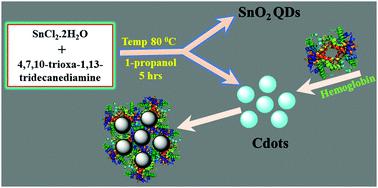当前位置:
X-MOL 学术
›
New J. Chem.
›
论文详情
Our official English website, www.x-mol.net, welcomes your feedback! (Note: you will need to create a separate account there.)
Luminescent carbogenic dots for the detection and determination of hemoglobin in real samples
New Journal of Chemistry ( IF 3.3 ) Pub Date : 2020-03-19 , DOI: 10.1039/d0nj00401d Farwa Arshad 1, 2, 3, 4 , Ayan Pal 1, 4, 5, 6 , Tipu Alam 1, 4, 5, 6 , Javed Alam Khan 4, 7, 8, 9 , Md Palashuddin Sk 1, 2, 3, 4
New Journal of Chemistry ( IF 3.3 ) Pub Date : 2020-03-19 , DOI: 10.1039/d0nj00401d Farwa Arshad 1, 2, 3, 4 , Ayan Pal 1, 4, 5, 6 , Tipu Alam 1, 4, 5, 6 , Javed Alam Khan 4, 7, 8, 9 , Md Palashuddin Sk 1, 2, 3, 4
Affiliation

|
4,7,10-Trioxa-1,13-tridecanediamine (TTDDA) is widely used for surface passivation during the synthesis of 0D quantum dots (QDs), whereas alcohol is commonly used as the reaction medium. However, following the completion of the reaction, the fate of excess TTDDA is hardly known. Herein, it is reported that luminescent carbogenic dots (Cdots) are simultaneously produced through the polymerization of TTDDA while preparing tin dioxide nanocrystals (SnO2 NCs) even at low temperatures (80 °C). The structural characteristics of the SnO2 NCs and Cdots were analyzed using spectroscopic and microscopic techniques. It is surmised that the oxidative coupling of TTDDA takes place initially, resulting in polymeric fragments. Such polymeric fragments undergo carbonization in the subsequent stages to generate highly luminescent carbogenic dots (termed as Cdots). The emission characteristics of Cdots (4.1 ± 0.8 nm) are found to be highly sensitive and selective towards the detection of trace amounts of hemoglobin (Hb), resulting in the turn-off of photoluminescence. Using spectrometric techniques, the limit of detection (LOD) for the Hb measurement is found to be 16 nM. The ground state complexation between Cdots and Hb accomplishes exceptional quenching behaviour. A fluorescent test strip fabricated with Cdots was prepared for the rapid on-spot determination of Hb. Finally, the as-prepared Cdots and their emission properties were successfully used for the selective detection and exact quantification of Hb in blood samples collected from volunteers. Also, the presence of trace amounts of blood in human urine was detected with a fluorescent test strip using the turn-off photoluminescence of Cdots. The present results suggest that the formation of luminescent carbogenic polymeric dots occurs as a side reaction during the synthesis of SnO2 NCs that results in highly fluorescent as-synthesized products.
中文翻译:

发光碳源点用于检测和测定实际样品中的血红蛋白
4,7,10-Trioxa-1,13-十三烷二胺(TTDDA)在合成0D量子点(QD)期间被广泛用于表面钝化,而醇通常用作反应介质。然而,在反应完成之后,几乎不知道过量的TTTDA的命运。在此,据报道,即使在低温(80℃)下,在制备二氧化锡纳米晶体(SnO 2 NCs)的同时,通过TTTDA的聚合同时产生发光的碳原子点(Cdot )。SnO 2的结构特征使用光谱和显微技术分析了NC和Cdot。据推测,TTTDA的氧化偶合最初发生,导致聚合物片段。这样的聚合物片段在随后的阶段中进行碳化,以产生高发光性的碳生成点(称为Cdot)。发现Cdots(4.1±0.8 nm)的发射特性对检测痕量的血红蛋白(H b)具有高度的敏感性和选择性,从而导致光致发光的关闭。使用光谱技术检测限(LOD)对H极限b测量被发现是16纳米。Cdots与H b之间的基态络合实现出色的淬火性能。制备了用Cdots制成的荧光测试条,用于快速现场测定H b。最后,所制备的Cdot及其发射特性已成功用于选择性检测和准确定量从志愿者那里收集的血液样本中的H b。同样,使用关闭Cdots的光致发光的荧光试纸条检测了人类尿液中微量血液的存在。目前的结果表明,发光的生碳聚合物点的形成是在SnO 2 NCs合成过程中作为副反应发生的,从而导致了高荧光的合成产物。
更新日期:2020-03-19
中文翻译:

发光碳源点用于检测和测定实际样品中的血红蛋白
4,7,10-Trioxa-1,13-十三烷二胺(TTDDA)在合成0D量子点(QD)期间被广泛用于表面钝化,而醇通常用作反应介质。然而,在反应完成之后,几乎不知道过量的TTTDA的命运。在此,据报道,即使在低温(80℃)下,在制备二氧化锡纳米晶体(SnO 2 NCs)的同时,通过TTTDA的聚合同时产生发光的碳原子点(Cdot )。SnO 2的结构特征使用光谱和显微技术分析了NC和Cdot。据推测,TTTDA的氧化偶合最初发生,导致聚合物片段。这样的聚合物片段在随后的阶段中进行碳化,以产生高发光性的碳生成点(称为Cdot)。发现Cdots(4.1±0.8 nm)的发射特性对检测痕量的血红蛋白(H b)具有高度的敏感性和选择性,从而导致光致发光的关闭。使用光谱技术检测限(LOD)对H极限b测量被发现是16纳米。Cdots与H b之间的基态络合实现出色的淬火性能。制备了用Cdots制成的荧光测试条,用于快速现场测定H b。最后,所制备的Cdot及其发射特性已成功用于选择性检测和准确定量从志愿者那里收集的血液样本中的H b。同样,使用关闭Cdots的光致发光的荧光试纸条检测了人类尿液中微量血液的存在。目前的结果表明,发光的生碳聚合物点的形成是在SnO 2 NCs合成过程中作为副反应发生的,从而导致了高荧光的合成产物。


























 京公网安备 11010802027423号
京公网安备 11010802027423号